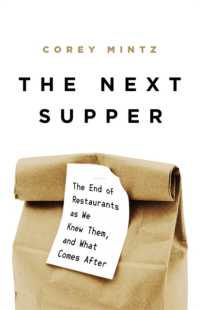Full Description
It's never been more challenging to teach physical education to children and adolescents. Between managing difficult behavior and adapting lessons for students with diverse needs, teachers have their hands full. Teaching Children and Adolescents Physical Education: Becoming a Master Teacher has been helping both new and experienced physical educators meet these challenges for many years, and this revised edition has been updated to address many of the new challenges that have emerged in the past decade. Expanded to address teaching across elementary, middle, and high school, this classic resource demonstrates the techniques and skills master teachers rely on. Many of these skills are illustrated with videotapes of actual K-12 teachers in action.
This already-successful text goes beyond pedagogy to include concrete curriculum strategies for making classes vibrant, fun, and developmentally appropriate. Written in conversational language, the book is readily applicable.
Teaching Children and Adolescents Physical Education has been refreshed to be more valuable than ever to veteran and future physical educators navigating the elementary, middle, and high school environment. New features include the following:
• New research and examples from the world of secondary physical education
• Technology tips and app ideas contributed by real physical educators
• Linked directly to national standards and grade-level outcomes (SHAPE America, 2014), a new approach to planning and teaching lessons to meet the needs of all students
• Many sample task sheets and assessment examples for middle and high school
In addition, this resource features three new chapters that add even more depth to the topics covered. The chapters address long-term planning, writing, and teaching the lesson plan.
The value of this book can be attributed to the authors' years of experience teaching physical education in elementary, middle, and high school. George Graham, Eloise Elliott, and Steve Palmer understand all aspects of quality physical education and the teaching challenges that come with the territory—because they have been there. Emphasizing real-world strategies, the authors weave instructional scenarios throughout the book. Readers will see in action the decision-making process master teachers go through when writing and teaching lesson plans. Because every class is different, this resource also highlights how to plan for diverse students and how to adjust lessons accordingly.
The text is packed with tried-and-true advice for motivating students to practice, building positive feelings, observing and analyzing, providing feedback, and assessing students through formative assessment. Examples show what effective physical education instruction really looks like in secondary gymnasiums and on playgrounds. Rich with firsthand advice and insight, this book will guide educators toward becoming master teachers of physical education.
Contents
Chapter 1. Successful Teaching
• The Teacher, Not Only the Content
• How Teaching Physical Education Differs From Teaching in the Classroom
• Analogies of Teaching
• Changing and Dynamic Nature of Teaching
• Difficulty of Describing Good Teaching
• Challenge of Teaching Physical Education
• The Teacher Makes the Difference
• Pedagogy Toolbox
• Working Definition of Successful
• Summary
Chapter 2. Creating a Positive Learning Environment
• Teacher Expectancy
• Teacher Stereotypes
• Creating an Emotionally Safe Environment
• Determining Management Protocols
• Teaching Behavior Protocols
• Summary
Chapter 3. Long-Term Planning
• Need for Planning
• Tendencies to Avoid Planning
• Planning Formats and Components
• Summary
Chapter 4. Writing the Lesson Plan
• Writing the Daily Lesson Plan
• Lesson Purpose: Learnable Pieces
• Developing the Content
• Major Parts of a Lesson Plan
• Lesson Components
• Adapting Lessons for Students With Special Needs
• Summary
Chapter 5. Teaching From the Lesson Plan
• Student Centered Versus Subject Centered
• Observation Techniques
• Four Key Content Development Questions
• Observing Individuals
• Observing Classes for Content Development
• Fun
• Summary
Chapter 6. Getting the Lesson Started
• Instant Activity
• Communicating the Purpose of the Lesson
• Traditional Ways to Start a Lesson
• Summary
Chapter 7. Instructing and Demonstrating
• Instructing
• Demonstrating
• Pinpointing
• Checking for Understanding
• Play-Teach-Play
• Using Video Technology
• Analyzing Students' Use of Time
• Summary
Chapter 8. Motivating Students to Practice
• Three Keys to Motivating Youngsters
• Eight Techniques for Motivating Students
• Developing Realistic Expectations
• Teacher as Cheerleader
• Summary
Chapter 9. Providing Feedback
• Types of Feedback
• Analyzing Your Feedback
• Research on Physical Education Teacher Feedback
• Summary
Chapter 10. Minimizing Off-Task Behavior and Discipline Problems
• Why Do Students Act Out?
• Strategies for Minimizing Off-Task Behavior
• Discipline Systems
• Characteristics of Effective Discipline Systems
• Disciplinary Confrontation
• Summary
Chapter 11. Building Critical Thinking Skills
• Value of Critical Thinking Experiences
• Convergent Problem Solving
• Divergent Problem Solving
• Verbal Problem Solving
• Necessary Teacher Characteristics
• Direct or Indirect Approach: Which Is Best?
• Summary
Chapter 12. Building Positive Feelings
• Inappropriate Practices
• Intentional and Ever Present
• Techniques and Strategies
• Testing
• Understanding Feelings
• Learned Helplessness
• Concluding Thoughts
• Summary
Chapter 13. Assessing and Reporting Student Progress
• Why Assess?
• What to Assess?
• Alternative Assessment
• Evaluating Assessment Data
• Standardized Assessments
• Reporting and Grading
• Summary
Chapter 14. Continuing to Develop as a Teacher
• Stages of Teaching
• Techniques for Continuing to Improve as a Teacher
• Seven Habits of Highly Effective Teachers
• What Type of Teacher Will You Become?
• Parting Thoughts
• Summary








